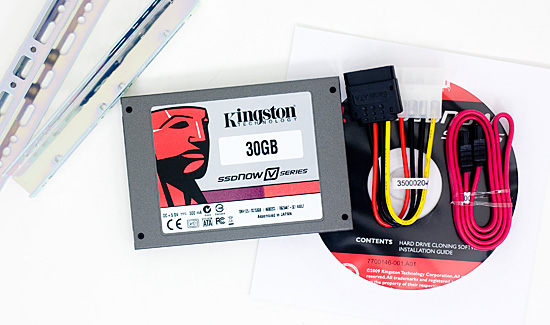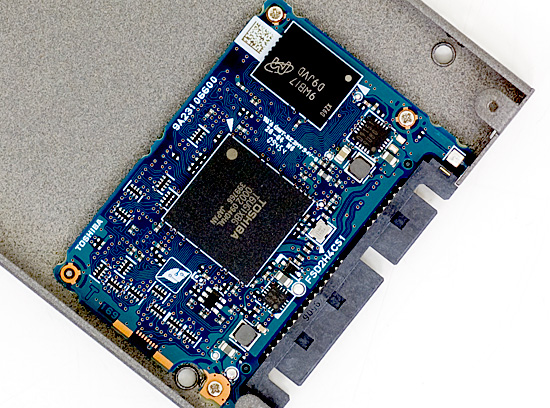Intel's X25-V & Kingston's 30GB SSDNow V Series: Battle of the $125 SSDs
by Anand Lal Shimpi on March 19, 2010 12:00 AM EST- Posted in
- Storage
Kingston’s 30GB SSDNow V Series Boot Drive
For $125, Kingston will sell you more of an upgrade kit than Intel will. The new 30GB V Series Boot Drive upgrade kit comes with 3.5” mounting brackets, cloning software, a molex to SATA power cable, a SATA data cable and the drive itself. If you just want the drive, Kingston will sell it to you for $110.

Inside the drive is a ridiculously small PCB screwed on so tight that I couldn’t even remove it for a look at the back.

The Toshiba T6UG1XBG controller on this drive is the same controller used in the latest Kingston SSDNow V+ Series drives. It supports TRIM but not NCQ, although as I found in my testing of the V+ drives the TRIM functionality is a bit odd.

Simply recognizing and accepting the TRIM command is one thing, what the drive’s controller and firmware choose to do with the data is another entirely. Some drives, like Intel’s X25-M and X25-V, appear to immediately flag all TRIMed LBAs for cleaning. This results in an immediate restoration to almost new performance when writing to those LBAs. Other drives, like those based on Toshiba’s T6UG1XBG controller, don’t show an immediate performance benefit when TRIMed. It’s unclear what the controller is doing with the TRIM information, but it doesn’t seem to be in a hurry to do anything with it.
With 32GB of actual MLC NAND on board, Kingston's drive is at a capacity deficit to the X25-V. A cleanly formatted drive only shows 28GB of free space in an OS and you can kiss more than half of that goodbye after you install your OS and a couple of applications. Kingston is hoping to make up for it by outperforming the X25-V. Let's get to it.










78 Comments
View All Comments
jed22281 - Saturday, March 27, 2010 - link
Given it's in a similar size category...Shouldn't the 50GB OWC Mercury Extreme be included in this?
Or is it only allowed to sit in X25-M territory?
Is that the only other competitor for the Mercury Extreme?
If true...
In which scenario/s might one pick the Extreme over the X25-M?
Thank-you!
thllxb - Saturday, March 27, 2010 - link
I actually bought one intel-v 40g and i got the shipment today. The sequential read is very good, 190mb/s with nvidia SATA controller driver and 170mb/s with win7 driver. However, the random read speed is only 22mb/s with both drivers, much lower than the test result 60mb/s. I still need to find out why.jed22281 - Friday, March 26, 2010 - link
Given it's in a similar size category...Shouldn't the 50GB OWC Mercury Extreme be included in this?
Or is it only allowed to sit in X25-M territory?
Is that the only other competitor for the Mercury Extreme?
If true...
In which scenario/s might one pick the Extreme over the X25-M?
Thank-you!
jed22281 - Thursday, March 25, 2010 - link
^^^ anyone? thank-you!jed22281 - Thursday, March 25, 2010 - link
^^^ anyone? thank-you!jed22281 - Wednesday, March 24, 2010 - link
Given it's in a similar size category...Shouldn't the 50GB OWC Mercury Extreme be included in this?
Or is it only allowed to sit in X25-M territory?
Is that the only other competitor for the Mercury Extreme?
If true...
In which scenario/s might one pick the Extreme over the X25-M?
Thank-you!
NandFlashGuy - Sunday, March 21, 2010 - link
Hi Anand,I think it's misleading that you continue using the phrase "IMFT Nand". This gives the impression that all IMFT Nand is equivalent.
IMFT does not sell Nand -- they are the just legal way that Micron and Intel can share the cost of manufacturing Nand together. Each parent company has the ability to define their own litho process or their own test strategies.
This means that the Nand on the X-25 series is "Intel Nand", not IMFT or Micron Nand. Moreover, the Nand on the X-25 series receives much more extensive testing than what is sold to the removable memory market.
chuckbam - Saturday, March 20, 2010 - link
Because of the growth size of the winsxs folder, I think 40GBs are to small for a boot drive.sdsdv10 - Sunday, March 21, 2010 - link
That might be the case for you, but not for everyone. I just upgraded my father-in-law's PC with one of the Intel 40GB SSD and a 250GB regular HD for data storage. Installation of Windows 7 Home Premium left just under 23GB of usable space. Besides IE, the only other thing he needed was Office 2003 (this took less than 350MB total). Still had 22GB of space left. It boots up very quick and opening programs in very fast (nearly instantaneous). A nice improvement over the previous incarnation with XP on a regular 7200rpm HD.JimmiG - Saturday, March 20, 2010 - link
28 or 37GB is definitely too small for me. If you're going to buy a SSD to speed things up, there must be enough space on it to actually install some stuff on it to speed up. If you can only speed up a few percent of your disk operations, it's pretty pointless.60GB would be the minimum for me, preferably 80+ GB. 30GB is barely enough for Win7 itself *or* a couple of games. I'm using 410GB on my "Applications" drive, the one that contains the OS and games and programs I use (almost no user data like movies or pictures).